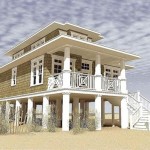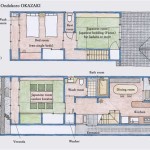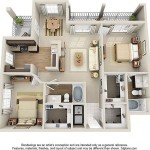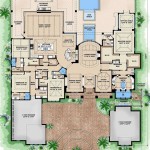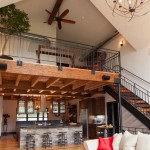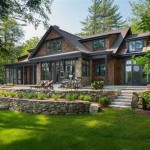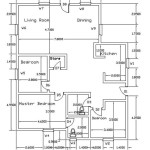2000 Sq Ft House Plans: One-Story, Four-Bedroom Layouts for Spacious Living
A 2000 square foot home provides ample space for families and individuals seeking comfortable living. When considering a one-story design, the challenge lies in maximizing functionality and flow within the available footprint. This article explores the key features and considerations for designing a 2000 sq ft, one-story, four-bedroom house plan, offering insights into maximizing space and achieving a desirable living experience.
Maximizing Space Utilization
One of the key challenges in designing a 2000 sq ft, one-story, four-bedroom home is maximizing space utilization. This involves optimizing layout, incorporating smart storage solutions, and considering the flow of traffic within the house. Here are some key considerations:
- Open Floor Plan: An open floor plan between the kitchen, dining, and living areas promotes a sense of spaciousness and facilitates natural light flow. It also allows for flexible furniture arrangements and creates a central hub for family interaction.
- Strategic Bedroom Placement: Positioning bedrooms strategically can enhance privacy and minimize noise transfer. For example, grouping bedrooms in one wing of the house can create a quiet zone separate from the main living areas.
- Dedicated Mudroom or Entryway: Including a mudroom or dedicated entryway provides a space for shoes, coats, and bags, preventing clutter from spilling into the main living areas. This can be especially beneficial in homes with children or active lifestyles.
- Built-in Storage: Incorporating built-in storage, such as closets, shelving, and cabinets, helps to optimize vertical space and keep belongings organized. This can be implemented in bedrooms, bathrooms, hallways, and other areas.
Functionality and Flow
Creating a functional and well-flowing floor plan is essential for a comfortable and efficient living experience. This involves considering the movement of people and the interaction between different spaces. Here are some key design elements to consider:
- Central Hallway: A well-planned central hallway provides easy access to bedrooms, bathrooms, and other rooms, promoting a logical flow throughout the home.
- Multi-Purpose Room: Consider incorporating a flexible space that can serve multiple purposes, such as a home office, playroom, or guest room. This allows adaptability to changing needs over time.
- Kitchen Island: A large kitchen island offers a focal point for the kitchen and provides additional counter space, seating, and storage. It can also create a functional separation between the kitchen and dining areas.
- Natural Light: Maximizing natural light through windows and skylights creates a bright and airy atmosphere. Strategically placed windows can also enhance the flow of fresh air and provide pleasant views.
- Outdoor Access: Designating dedicated entrances to outdoor spaces, such as a patio or deck, allows for seamless indoor-outdoor living, creating a connection with the environment.
Customization and Personalization
Beyond the fundamental layout, customization and personalization play a crucial role in creating a home that reflects individual needs and preferences. This can be achieved through:
- Floor Plan Modifications: Adjusting the size and placement of rooms to suit individual needs and lifestyle can be done by modifying the basic floor plan. For example, enlarging a master bedroom suite or adding a dedicated laundry room.
- Exterior Design: Choosing an exterior style that complements the surrounding neighborhood and reflects personal aesthetics is crucial. Options range from traditional styles to modern and contemporary designs.
- Interior Finishes: Selecting flooring, wall finishes, and fixtures that align with personal taste and lifestyle creates a cohesive and comfortable ambiance. This can involve using a variety of materials, textures, and colors.
- Smart Home Features: Integrating smart home features, such as automated lighting, thermostats, and security systems, enhances convenience and control over the home environment.
Considerations for Specific Needs
When designing a 2000 sq ft, one-story, four-bedroom house plan, it's essential to consider the specific needs of the intended occupants. This includes:
- Accessibility: If the home is designed for individuals with accessibility needs, wide doorways, ramps, and accessible bathroom fixtures are crucial.
- Family Composition: When designing for families with children, consider the need for play areas, separate bedrooms for privacy, and ample storage for toys and clothes.
- Climate: In hot climates, prioritize cross-ventilation and shade to ensure a comfortable indoor temperature. In cold climates, focus on insulation, efficient heating systems, and sun exposure to minimize energy consumption.
- Lifestyle: An active lifestyle might require a larger garage or dedicated storage for equipment. A home office or workspace is essential for those working from home.
Designing a 2000 sq ft, one-story, four-bedroom house plan requires careful consideration of space utilization, functionality, flow, customization, and specific needs. By integrating these factors into the design process, you can create a comfortable, functional, and personalized home that meets the needs and aspirations of its occupants.

House Plan 041 00082 European 2 000 Square Feet 4 Bedrooms Bathrooms New Plans Acadian Small Floor

2 000 Sq Ft House Plans Houseplans Blog Com

Farmhouse House Plan With 2000 Square Feet And 4 Bedrooms S From Dream Home Source Country Plans One Story Style

4 Bedroom 3 Bath 1 900 2 400 Sq Ft House Plans

Floor Plan 4 Bedrooms 2 Living Rooms Under 2000 Sq Ft Bonus Room Bedroom House Plans New

4 Bed Modern Ranch Home Plan Under 2000 Square Feet 420080wnt Architectural Designs House Plans

2 000 Sq Ft House Plans Houseplans Blog Com

10 Best 2000 Sq Ft House Plans According To Vastu Shastra 2024

Hpg 20002 1 The Forrest Wood House Plans

2 000 Sq Ft House Plans Houseplans Blog Com
Related Posts

